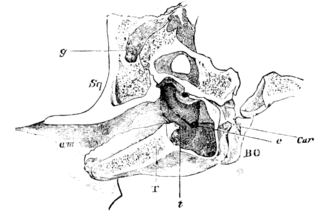swollen, and there is but little flattening towards the meatus: the paroccipital processes, though slight, are in contact with the bullae basally, though their free tips are turned away from them. Finally, in Ictonyx the bullae are much swollen; there is but little flattening towards the meatus, and the paroccipital processes, themselves much swollen, are pressed closely against the bullae. The Mustelidae, therefore, in this as in other characters, approach the Aeluroids.

Fig. 212.—Section of the left auditory bulla and surrounding bones of a Bear (Ursus ferox). am, External auditory meatus; BO, basioccipital; Car, carotid canal; e, Eustachian canal; g, glenoid canal; Sq, squamosal; T, tympanic; t, tympanic ring. (From Flower, Proc. Zool. Soc. 1869.)
There is no caecum, a feature which marks off the Arctoidea from all Carnivora except the Viverrids Nandinia and Arctictis (occasionally). The brain is characterised by the possession of what Dr. Mivart has described as the "ursine lozenge," a tract about the middle of the hemispheres, defined posteriorly by the crucial sulcus, and formed by the emergence on to the surface of the brain of the hippocampal gyrus.
The Arctoidea are very widely distributed. But there are some curious exceptions. Thus there are no representatives of the group (as might be expected) in the Australian region; they are completely absent from Madagascar; while the true Bears (family Ursidae) are totally absent from Ethiopian Africa, and are only represented by a single species, Ursus ornatus, in the Neotropical region.
It is noteworthy that the Arctoidea never show spots or
